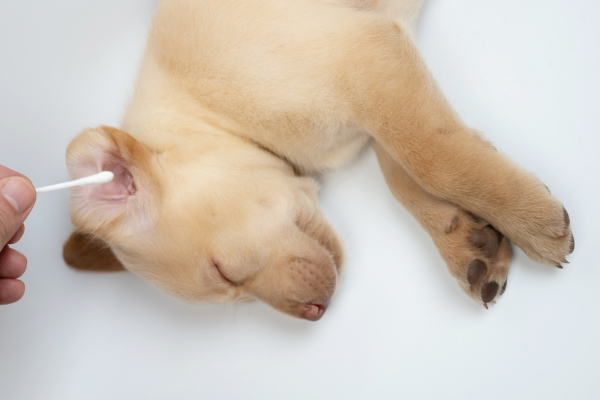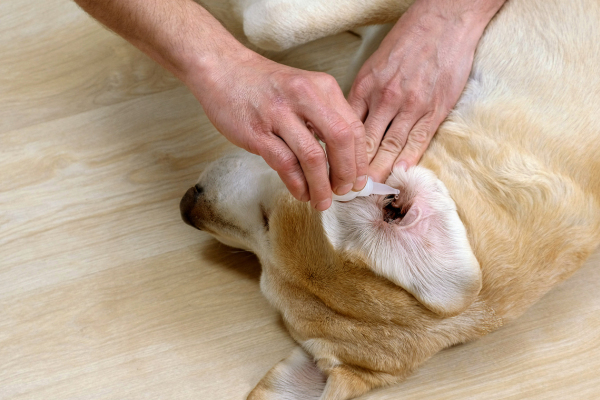
As pet owners, one of the most distressing things to witness is our furry companions in pain or discomfort. One of the most common issues dogs face, especially those with floppy ears or excessive earwax, is ear infections. An ear infection can cause your dog to scratch their ears excessively, shake their head, or even show signs of irritability or pain. If left untreated, an ear infection can lead to more severe issues, including hearing loss. But don’t worry—treating a dog ear infection can be straightforward if you know the signs and the right approach.
In this article, we’ll guide you through how to identify, treat, and prevent ear infections in dogs, ensuring that your pup stays comfortable and healthy.
Recognizing the Signs of an Ear Infection in Dogs
Before jumping into treatment, it’s important to recognize the signs that your dog might be suffering from an ear infection. Symptoms can vary depending on the type of infection (bacterial, yeast, or fungal), but the following are common signs to look out for:
- Frequent scratching or rubbing of the ears
- Head shaking or tilting
- Redness or swelling inside the ear
- Excessive earwax or discharge (which may be yellow, brown, or bloody)
- Odor coming from the ear
- Pain or sensitivity when touching the ear
- Hearing issues or balance problems (in severe cases)
If you notice any of these signs, it’s essential to take action as soon as possible to avoid complications. While some infections may resolve with at-home care, others require veterinary intervention.
Steps to Treat a Dog Ear Infection at Home

Treating an ear infection in dogs depends on the severity of the infection, but many mild cases can be managed with home care. Here’s a step-by-step guide to help you treat your dog’s ear infection safely and effectively:
1. Consult Your Veterinarian
While there are effective home remedies, it’s always best to get a professional diagnosis. Your vet can confirm whether the infection is bacterial, yeast-based, or due to another cause, such as mites or allergies. The vet will also ensure there are no underlying issues such as a ruptured eardrum or foreign object in the ear.
2. Clean the Ear Gently
If your vet has advised you to clean the ear, you can do this at home. Cleaning helps remove dirt, debris, and excess wax, which may help alleviate the infection and prevent it from worsening. Use a dog-safe ear cleaner recommended by your vet, or opt for natural alternatives like a mixture of equal parts water and apple cider vinegar (check with your vet first).
Steps for cleaning:
- Apply ear cleaner: Gently apply a few drops of the ear cleaner into the ear canal.
- Massage the ear: Lightly massage the base of the ear to loosen the debris and wax.
- Wipe the ear: Use a cotton ball or gauze pad to gently wipe the inside of the ear. Avoid using cotton swabs, as they can push debris further into the ear canal.
- Dry the ear: Ensure the ear is dry after cleaning to prevent the growth of yeast or bacteria.
3. Apply Medication as Directed
If your vet has prescribed medication (like topical ointments, antibiotics, or antifungal treatments), it’s crucial to follow the instructions carefully. Medications help clear up infections, reduce inflammation, and alleviate pain.
How to apply medication:
- Follow dosage instructions: Apply the prescribed ointment or drops according to the vet’s recommendations, typically once or twice daily.
- Be consistent: Even if your dog seems to feel better, continue with the full course of treatment to ensure the infection is fully treated and doesn’t return.
4. Prevent Your Dog from Scratching
Scratching can worsen an ear infection and even cause further injury to the ear canal. To help prevent this:
- Use an Elizabethan collar (cone) to prevent your dog from scratching or rubbing their ears.
- Monitor your dog: Keep an eye on your dog to ensure they’re not excessively rubbing their ears on furniture, walls, or other surfaces.
5. Maintain a Dry Environment
Moisture in the ears can make infections worse, so keeping your dog’s ears dry is crucial. If your dog has been swimming or bathing, gently dry their ears after the activity with a soft towel.
6. Treat Underlying Causes
Ear infections often occur due to allergies, parasites (like ear mites), or environmental factors. Treating the underlying cause of the infection is key to preventing future issues:
- Address allergies: If your dog has food or environmental allergies, talk to your vet about managing them to reduce ear infection recurrence.
- Treat parasites: If ear mites or fleas are contributing to the infection, your vet can prescribe medications or treatments to eliminate them.
When to See the Veterinarian
In some cases, ear infections require more than just home treatment. If your dog’s symptoms persist or worsen despite at-home care, or if you notice any of the following signs, it’s important to consult with your veterinarian immediately:
- Severe pain or swelling
- Green or bloody discharge
- Foul odor coming from the ear
- Signs of hearing loss or imbalance
- Lack of improvement after a few days of treatment
Your vet will be able to perform tests (such as a cytology or culture) to identify the exact cause of the infection and may prescribe a more specific treatment plan.
How to Prevent Future Ear Infections
Once you’ve successfully treated your dog’s ear infection, the next step is prevention. Here are a few tips to help keep your dog’s ears healthy:
- Regular ear cleaning: Clean your dog’s ears regularly (every 2–4 weeks) to prevent the buildup of wax and debris. If your dog is prone to infections, ask your vet how often you should clean their ears.
- Keep ears dry: Always dry your dog’s ears thoroughly after swimming, baths, or walks in the rain.
- Watch for allergies: If your dog has allergies, work with your vet to control them and reduce the likelihood of ear infections.
- Use ear drops: For dogs prone to recurring infections, your vet may recommend preventive ear drops.
Ear infections are a common issue for dogs, but with prompt treatment and proper care, most infections can be managed successfully. By following the right cleaning techniques, using the appropriate medication, and addressing any underlying issues, you can help your dog recover quickly and prevent future infections. Remember, always consult your vet if you’re unsure about treatment or if the symptoms persist.
By being proactive, you can ensure that your dog’s ears stay clean, healthy, and infection-free, keeping them comfortable and happy for years to come.





